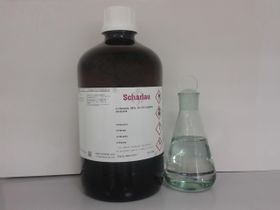Hexane
 n-Hexane bottle and a small sample
| |
| Names | |
|---|---|
| IUPAC name
Hexane
| |
| Other names
n-Hexane
| |
| Identifiers | |
| Jmol-3D images | Image |
| |
| Properties | |
| C6H14 | |
| Molar mass | 86.18 g/mol |
| Appearance | Colorless liquid |
| Odor | Gasoline-like |
| Density | 0.6548 g/ml |
| Melting point | −96 to −94 °C (−141 to −137 °F; 177 to 179 K) |
| Boiling point | 68.5 to 69.1 °C (155.3 to 156.4 °F; 341.6 to 342.2 K) |
| 9.5 mg/L | |
| Solubility | Miscible with ethanol |
| Vapor pressure | 17.60 kPa (at 20.0 °C) |
| Thermochemistry | |
| Std molar
entropy (S |
296.06 J K−1 mol−1 |
| Std enthalpy of
formation (ΔfH |
−199.4–−198.0 kJ mol−1 |
| Hazards | |
| Safety data sheet | LabChem |
| Flash point | −26.0 °C |
| Lethal dose or concentration (LD, LC): | |
| LD50 (Median dose)
|
25 g/kg (oral, rat) 28710 mg/kg (rat, oral) |
| LC50 (Median concentration)
|
56137 mg/kg (rat, oral) |
| Related compounds | |
| Related compounds
|
Pentane Heptane |
| Except where otherwise noted, data are given for materials in their standard state (at 25 °C [77 °F], 100 kPa). | |
| Infobox references | |
Hexane or n-hexane is an alkane, containing six carbon atoms, with the chemical formula C6H14.
Contents
[hide]Properties
Chemical
Hexane will burn in air when ignited:
- C6H14 + 19/2 O2 → 6 CO2 + 7 H2O + heat
Hexane will react with bromine under UV light to yield bromohexane.
Physical
Hexane is a colorless liquid, with a petrolic odor, similar to lighter fluid. It is insoluble in water, but miscible with many organic solvents. It has a melting point of −95.3 °C and a boiling point of 68.7 °C. Hexane has considerable vapor pressure at room temperature (121.26 mmHg). It has a density of 0.6548 g/ml. Hexane is flammable, with a flash point of −26.0 °C and an autoignition temperature of 234.0 °C.
Availability
Certain lighter fluids contain n-hexane.
Stoddard solvent contains n-hexane along other alkanes, which can be separated via fractal distillation. However this may require large amounts of solvent.
Some rubber cements contain hexane as solvent, though not all.
Preparation
Hexane can be extracted by fractual distillation of gasoline, though this process is intense and time-consuming.
Projects
- Extract oils from plants
- Chemical reaction medium for organometallic reactions
- N-buthyllithium storage
Handling
Safety
Hexane is irritant to the nose and eyes. The acute toxicity of n-hexane is rather low, however it can be metabolized by the organism to hexane-2,5-dione which is toxic. Long term exposure poses a health hazard. It's suspected to cause disruptions to the reproductive system.
Storage
Hexane must be stored in closed bottles, away from any heat or light source. Due to its high vapor pressure, it's mandatory to keep the bottle open or semi-open after being moved from a cold area to a warmer one, to prevent a dangerous build-up of pressure, until the entire content of the bottle reaches the room temperature.
Disposal
Hexane can be safely burned as it only releases carbon oxides and water vapor and extremely little soot.
References
Relevant Sciencemadness threads
- Chemical pages without CAS Registry Number
- Articles without EBI source
- Chemical pages without ChemSpiderID
- Chemical pages without DrugBank identifier
- Articles without KEGG source
- Articles without InChI source
- Articles without UNII source
- Articles containing unverified chemical infoboxes
- Chemical compounds
- Organic compounds
- Hydrocarbons
- Alkanes
- Solvents
- Nonpolar solvents
- Volatile chemicals
- Liquids
- Essential reagents